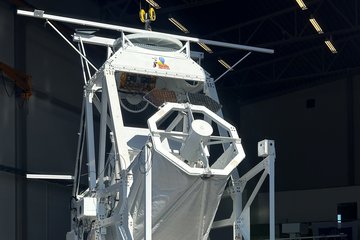All genres
21.
Journal Article
Stellar limb darkening. A new MPS-ATLAS library for Kepler, TESS, CHEOPS, and PLATO passbands. Astronomy and Astrophysics 666, p. A60 (2022)
22.
Journal Article
Faculae Cancel out on the Surfaces of Active Suns. The Astrophysical Journal 934, p. L23 (2022)
23.
Journal Article
Erratum: "Faculae Cancel out on the Surfaces of Active Suns" (2022, ApJL, 934, L23). The Astrophysical Journal 936, p. L17 (2022)
24.
Journal Article
Faculae Cancel out on the Surfaces of Active Suns. The Astrophysical Journal 934, p. L23 (2022)
25.
Journal Article
Chromospheric extension of the MURaM code. Astronomy and Astrophysics 664, p. A91 (2022)
26.
Journal Article
Measuring Periods in Aperiodic Light Curves-Applying the GPS Method to Infer the Rotation Periods of Solar-like Stars. The Astrophysical Journal 938, p. L1 (2022)
27.
Journal Article
Predictions of Astrometric Jitter for Sun-like Stars. III. Fast Rotators. The Astrophysical Journal 934, p. 146 (2022)
28.
Journal Article
Predictions of Astrometric Jitter for Sun-like Stars. III. Fast Rotators. The Astrophysical Journal 934, p. 146 (2022)
29.
Journal Article
Superflares on solar-like stars. A new method for identifying the true flare sources in photometric surveys. Astronomy and Astrophysics 668, p. A167 (2022)
30.
Journal Article
Can 1D Radiative-equilibrium Models of Faculae Be Used for Calculating Contamination of Transmission Spectra? The Astrophysical Journal 941, p. L35 (2022)
31.
Journal Article
Radiative Transfer with Opacity Distribution Functions: Application to Narrowband Filters. The Astrophysical Journal Supplement Series 255 (1), 3 (2021)
32.
Journal Article
Forward modelling of Kepler-band variability due to faculae and spots. Monthly Notices of the Royal Astronomical Society 504 (4), pp. 4751 - 4767 (2021)
33.
Journal Article
Irradiance Variations of the Sun and Sun-Like Stars - Overview of Topical Collection. Solar Physics 296 (4), 60 (2021)
34.
Journal Article
Where Have All the Solar-like Stars Gone? Rotation Period Detectability at Various Inclinations and Metallicities. The Astrophysical Journal Letters 908 (2), L21 (2021)
35.
Journal Article
Predictions of Astrometric Jitter for Sun-like Stars. I. The Model and Its Application to the Sun as Seen from the Ecliptic. The Astrophysical Journal 908 (2), 223 (2021)
36.
Journal Article
Predictions of Astrometric Jitter for Sun-like Stars. II. Dependence on Inclination, Metallicity, and Active-region Nesting. The Astrophysical Journal 919 (2), 94 (2021)
37.
Journal Article
Predictions of Astrometric Jitter for Sun-like Stars. II. Dependence on Inclination, Metallicity, and Active-region Nesting. The Astrophysical Journal 919, p. 94 (2021)
38.
Journal Article
Modeling Stellar Ca ii H and K Emission Variations. I. Effect of Inclination on the S-index. The Astrophysical Journal 914 (1), 21 (2021)
39.
Journal Article
Modeling Stellar Ca II H and K Emission Variations. I. Effect of Inclination on the S-index. The Astrophysical Journal 914, p. 21 (2021)
40.
Journal Article
MPS-ATLAS: A fast all-in-one code for synthesising stellar spectra. Astronomy and Astrophysics 653, A65 (2021)











